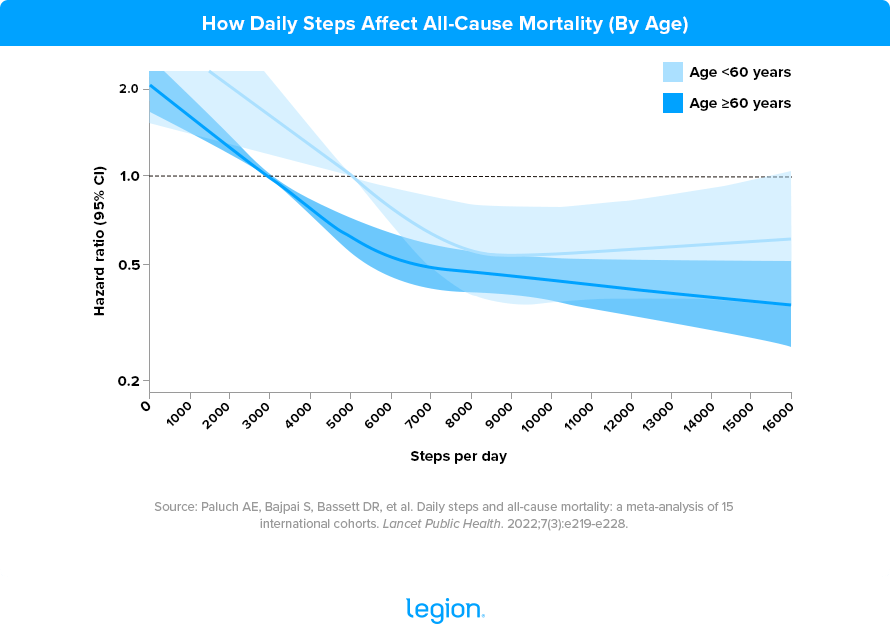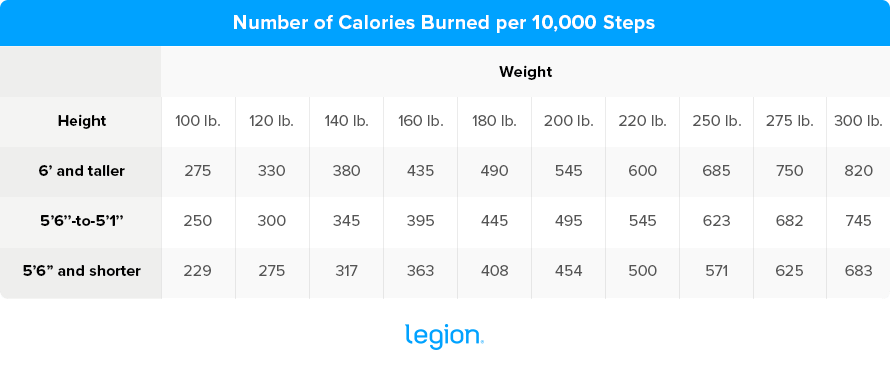[ad_1]
Most people have heard that you should walk 10,000 steps daily to optimize your well-being and longevity.
Most also assume this recommendation is based on scientific evidence that walking 10,000 steps a day is the “sweet spot” for boosting health and that taking more or fewer steps is less effective.
Is the 10,000-step recommendation as beneficial and evidence-based as many believe, though?
Or should we walk more or less than this to stave off disease and dysfunction?
Here’s what science says.
The Origin of the “10,000-Step” Goal
Many people assume the common recommendation to walk 10,000 steps per day is based on research.
That is, they believe that through rigorous investigation, scientists discovered that walking 10,000 steps a day confers health benefits that walking more or fewer steps does not.
This isn’t actually the case, though.
The 10,000-step goal originated as a 1960s marketing campaign by a Japanese pedometer manufacturer, who noticed that the Japanese character for “10,000” resembled someone walking (万) and decided to call their product the “10,000-step meter.”
The campaign was hugely successful and cemented 10,000 steps as the daily benchmark for walkers worldwide.
Should You Be Walking 10,000 Steps A Day?
Most people who strive to walk 10,000 steps daily do so because they believe it’ll boost their health and longevity.
However, given that there’s no scientific basis for it walking 10,000 steps a dayis it still a worthwhile goal?
In 2022 meta-analysis conducted by an international team of scientists and led by the University of Massachusetts suggests it can be for people of a certain age.
The researchers parsed the data from 15 studies involving almost 50,000 adults from across the world to identify the number of daily steps that will maximally improve health and longevity. They also wanted to investigate whether the optimal number of steps differs depending on age.
Their results showed the more steps you take per day, the lower your risk of all-cause mortality (dying from any cause), with the risk plateauing at 6,000-to-8,000 daily steps for people aged 60 and older and 8,000-to-10,000 daily steps for people younger than 60.
In other words, if you’re 60 or older, doing 6,000-to-8,000 daily steps is enough to maximally lower your risk of dying from any cause, but doing more doesn’t decrease your risk further. Likewise, if you’re younger than 60, doing 8,000-to-10,000 steps per day is enough to maximally lower your risk of dying from any cause, but doing more won’t decrease your risk further.
Here’s a graph from the study illustrating this:

The researchers also dug further into the data, grouping the walkers into “quartiles” based on how many steps they typically did each day. The lowest quartile averaged ~3,500 steps; the second, ~5,800 steps; the third, ~7,800 steps; and the fourth, ~10,900 steps.
This sub-analysis showed that the 3 most active quartiles had a 40-to-53% lower risk of death (relatively speaking) than those in the least active quartile.
This suggests you have the most to gain from increasing your daily steps if you’re very inactive. For instance, if you do 3,500 steps a day or fewer, you can greatly improve your health by bumping your daily steps up to around 6,000.
Finally, the researchers found that walking speed mattered little—provided you do enough daily steps, the rate you do them isn’t important.
These results are largely in step (har har) with several others recent studiestoo.
The only notable distinction is that one study conducted by scientists at the University of Southern Denmark found that walking quickly is probably slightly better than ambling for staving off dementia.
Thus, for anyone under 60, walking 8,000-to-10,000 steps per day is a good goal for maximizing your health. And if you’re older, aiming for between 6,000 and 8,000 daily steps is likely more fitting.
One more point worth mentioning is that while walking is a great form of exercise, it’s not enough to maximize all dimensions of your health. To do that, you should also be lifting weights, as strength training offers a number of benefits you simply can’t get from any amount of walking.
If you’d like to learn which strength training program you should follow to optimize your health, take the Legion Strength Training Quizand in less than a minute, you’ll know the perfect strength training program for you. Click here to check it out.)
Likewise, if you’re already following a strength training programit’s likely that you can maximize your health with fewer steps per day, since you’re already getting some exercise in the gym.
Tips to Help You Increase Your Daily Step Count
1. Go for a daily walk.
The easiest way to increase the number of steps you do each day is to schedule a 30-to-60-minute daily walk.
If you’re particularly time-pressed and dedicating 30-to-60 minutes each day to walking is impractical, try combining walking with activities you must do anyway. For example, walk while you take work calls, do remote meetings, or listen to an audiobook.
2. Don’t sit when you can walk.
Another excellent way to increase your daily step count is to look for occasions throughout the day when you’d ordinarily sit and walk instead.
For instance, instead of catching up with friends at a coffee shop, get your coffee to-go and socialize while strolling. Or, rather than driving to the grocery store to pick up last-minute dinner ingredients after work, leave it there instead.
3. Don’t stand still when you can move.
There are often periods throughout the day when you have to stand. Identify these times and turn them into opportunities to boost your step count.
For example, take the stairs instead of standing on an escalator or in a lift, pace the kitchen while waiting for your dinner to cook or the bathroom while brushing your teeth, or kill time while waiting for a bus or train by walking to the next stop.
FAQ #1: How many miles are 10,000 steps?
Most people have a step length of ~2.2-to-2.6 feet, which means it takes approximately 2,000-to-2,400 steps to walk a mile. Thus, 10,000 steps is ~4-to-5 miles for most people.
FAQ #2: How many calories does 10,000 steps burn?
Use the table below to estimate the number of calories you burn walking 10,000 steps based on your height and weight:

FAQ #3: How long does it take to walk 10,000 steps?
It depends on how fast you walk. 🙂
Most people between the ages of 18 and 50 walk about 3 miles per hour, whereas older folk walk closer to 2-to-2.5 miles per hour.
Thus, if you’re relatively young, you should be able to walk 10,000 steps in about 80-to-100 minutes. If you’re a little older (or typically walk slowly), it’ll take approximately 90-to-150 minutes.
+ Scientific References
- Paluch, AE, Bajpai, S., Bassett, DR, Carnethon, MR, Ekelund, U., Evenson, KR, Galuska, DA, Jefferis, BJ, Kraus, WE, Lee, IM, Matthews, CE, Omura, JD, Patel, AV, Pieper, CF, Rees-Punia, E., Dallmeier, D., Klenk, J., Whincup, PH, Dooley, EE, … Fulton, JE (2022). Daily steps and all-cause mortality: a meta-analysis of 15 international cohorts. The Lancet. Public Health, 7(3), e219–e228. https://doi.org/10.1016/S2468-2667(21)00302-9
- Del Pozo Cruz, B., Ahmadi, MN, Lee, IM, & Stamatakis, E. (2022). Prospective Associations of Daily Step Counts and Intensity With Cancer and Cardiovascular Disease Incidence and Mortality and All-Cause Mortality. JAMA Internal Medicine, 182(11), 1139–1148. https://doi.org/10.1001/JAMAINTERNMED.2022.4000
- Oftedal, S., Holliday, EG, Attia, J., Brown, WJ, Collins, CE, Ewald, B., Glozier, N., McEvoy, M., Morgan, PJ, Plotnikoff, RC, Stamatakis, E., Vandelanotte, C., & Duncan, MJ (2020). Daily steps and diet, but not sleep, are related to mortality in older Australians. Journal of Science and Medicine in Sport, 23(3), 276–282. https://doi.org/10.1016/J.JSAMS.2019.09.018
- Lee, IM, Shiroma, EJ, Kamada, M., Bassett, DR, Matthews, CE, & Buring, JE (2019). Association of Step Volume and Intensity With All-Cause Mortality in Older Women. JAMA Internal Medicine, 179(8), 1105–1112. https://doi.org/10.1001/JAMAINTERNMED.2019.0899
- Mañas, A., del Pozo Cruz, B., Ekelund, U., Losa Reyna, J., Rodríguez Gómez, I., Carnicero Carreño, JA, Rodríguez Mañas, L., García García, FJ, & Ara, I. (2022). Association of accelerometer-derived step volume and intensity with hospitalizations and mortality in older adults: A prospective cohort study. Journal of Sport and Health Science, 11(5), 578–585. https://doi.org/10.1016/J.JSHS.2021.05.004
- MURRAY, MP, DROUGHT, AB, & KORY, RC (nd). WALKING PATTERNS OF NORMAL MEN – PubMed. Retrieved May 7, 2023, from https://pubmed.ncbi.nlm.nih.gov/14129683/
- Murray, MP, Kory, RC, & Sepic, SB (nd). Walking patterns of normal women – PubMed. Retrieved May 7, 2023, from https://pubmed.ncbi.nlm.nih.gov/5501933/
- Ainsworth, BE, Haskell, WL, Herrmann, SD, Meckes, N., Bassett, DR, Tudor-Locke, C., Greer, JL, Vezina, J., Whitt-Glover, MC, & Leon, AS (2011) . 2011 compendium of physical activities: A second update of codes and MET values. Medicine and Science in Sports and Exercise, 43(8), 1575–1581. https://doi.org/10.1249/MSS.0B013E31821ECE12
- Alves, F., Cruz, S., Ribeiro, A., Silva, AB, Martins, J., & Cunha, I. (2020). Walkability index for elderly health: A proposal. Sustainability (Switzerland), 12(18). https://doi.org/10.3390/SU12187360
[ad_2]
Source link



